1.5years after I got the Fromeco Arizona, I finally put it to use on the 700N, reason being I simply couldn't sell the new in package Arizona for a decent price.
The installation was a nightmare. The footprint of the arizona is some much larger than the dualsky vr-8l that I was running. I had to rearrange all the electronics on the rx tray. Wires are still as messy as before. The heatsink is smaller than the dualsky unit and it is much lighter, but the cat spline thingy that comes along with it takes a lot of mounting space.
I made a switch for it by taking a normal switch lead and shorting out plug to the rx lead. It is vital to short out the rx lead and not the charge lead of a non-failsafe switch.

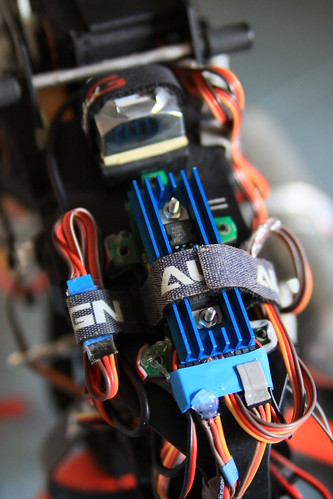
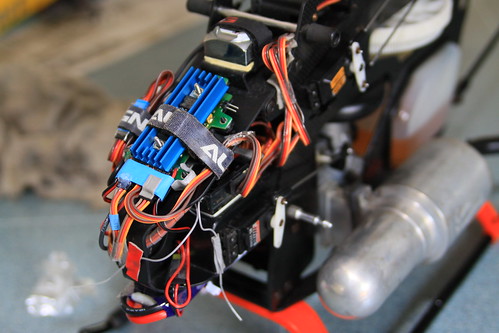
The Futaba 6014FS receiver that was previously on top of the tray couldn't fit into the radio tray. So it was replaced with a 608FS.
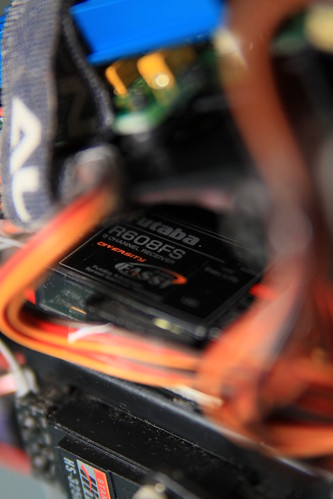
I also replaced the Flightpower evo-rx 2100mah lipo with a Turnigy 25c nano-tech 1800mah. The wires on the turnigy are oversized.
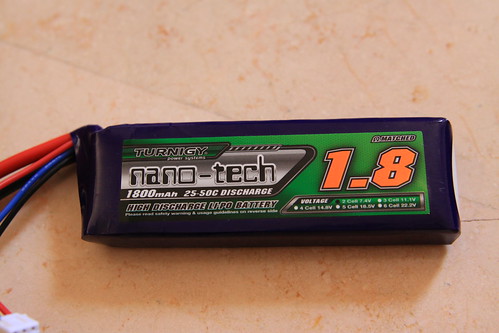
I have also start using the XT60 connector made popular by the hobby city stuff. It is very tight and secure, but yet easy to remove, unlike deans. The connectors are like bullets with half end cup and thus, are very easy to solder. It should be possible to fit 10awg wires on these, but if you need 10awg, you probably need larger connectors. I believe they should be able to withstand up to 6s/8s spark. The deans on the Arizona was replaced with XT60 connector.
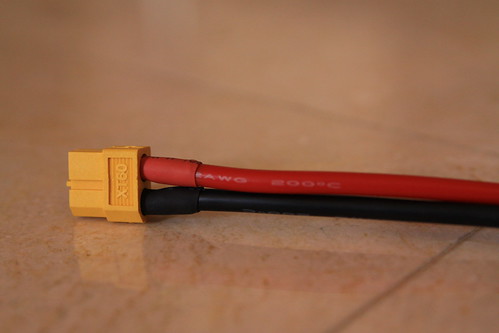
Flight Performance
Lipo performance can never be determine by tiny RX pack duty, so I will skip that. The Arizona performed ok, but it got pretty warm on a 32C day. I had the voltage output to the cyclic servo set at 6v, so it will probably get even warmer should the output voltage be dropped to 5v. The heatsink is definitely much less efficient than the dualsky. IMO, this regulator is not worth the price it cost, and the same pretty much stands for most regulators in the market. I am only using it because I can't sell it for a decent price. Otherwise, I would have stuck with the dualsky vr-8l, which actually runs cooler.
Seriously speaking, looking at the heatsink size and area of the arizona and most other regulator with even smaller heatsink, I don't see how they can do their rated 8A-15A in our hot tropical climate. I mean this is simple physics. No matter how good a linear regulator is, the amount of heat it has to dissipate is V*I, where V is the voltage difference between input and output. At 7.4v input and 6v output, doing 10A will mean trying to get rid of 14w of heat, which is impossible without running the regulator at higher than boiling water temperate. Spikes of 10A is ok, but continuous 10A is simply just B.S. by the marketing department, since nobody will ever pull 10A throughout the whole flight.
Overall the Arizona is a ok regulator, but there is no doubt it does get warmer than the VR-8L. The key features are the ability for a fail-safe switch, dual voltage output and decently sized heatsink. The current version of the Arizona, which mine is, are capable of doing 7.4v output to the cyclic servo.
The installation was a nightmare. The footprint of the arizona is some much larger than the dualsky vr-8l that I was running. I had to rearrange all the electronics on the rx tray. Wires are still as messy as before. The heatsink is smaller than the dualsky unit and it is much lighter, but the cat spline thingy that comes along with it takes a lot of mounting space.
I made a switch for it by taking a normal switch lead and shorting out plug to the rx lead. It is vital to short out the rx lead and not the charge lead of a non-failsafe switch.



The Futaba 6014FS receiver that was previously on top of the tray couldn't fit into the radio tray. So it was replaced with a 608FS.

I also replaced the Flightpower evo-rx 2100mah lipo with a Turnigy 25c nano-tech 1800mah. The wires on the turnigy are oversized.

I have also start using the XT60 connector made popular by the hobby city stuff. It is very tight and secure, but yet easy to remove, unlike deans. The connectors are like bullets with half end cup and thus, are very easy to solder. It should be possible to fit 10awg wires on these, but if you need 10awg, you probably need larger connectors. I believe they should be able to withstand up to 6s/8s spark. The deans on the Arizona was replaced with XT60 connector.

Flight Performance
Lipo performance can never be determine by tiny RX pack duty, so I will skip that. The Arizona performed ok, but it got pretty warm on a 32C day. I had the voltage output to the cyclic servo set at 6v, so it will probably get even warmer should the output voltage be dropped to 5v. The heatsink is definitely much less efficient than the dualsky. IMO, this regulator is not worth the price it cost, and the same pretty much stands for most regulators in the market. I am only using it because I can't sell it for a decent price. Otherwise, I would have stuck with the dualsky vr-8l, which actually runs cooler.
Seriously speaking, looking at the heatsink size and area of the arizona and most other regulator with even smaller heatsink, I don't see how they can do their rated 8A-15A in our hot tropical climate. I mean this is simple physics. No matter how good a linear regulator is, the amount of heat it has to dissipate is V*I, where V is the voltage difference between input and output. At 7.4v input and 6v output, doing 10A will mean trying to get rid of 14w of heat, which is impossible without running the regulator at higher than boiling water temperate. Spikes of 10A is ok, but continuous 10A is simply just B.S. by the marketing department, since nobody will ever pull 10A throughout the whole flight.
Overall the Arizona is a ok regulator, but there is no doubt it does get warmer than the VR-8L. The key features are the ability for a fail-safe switch, dual voltage output and decently sized heatsink. The current version of the Arizona, which mine is, are capable of doing 7.4v output to the cyclic servo.

No comments :
Post a Comment